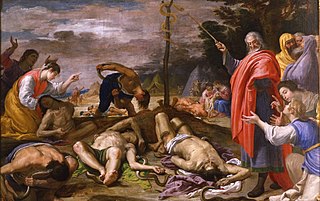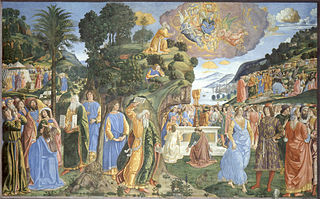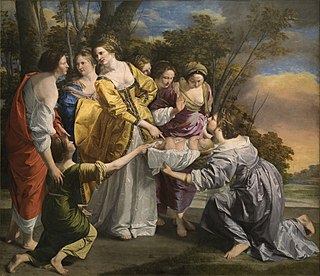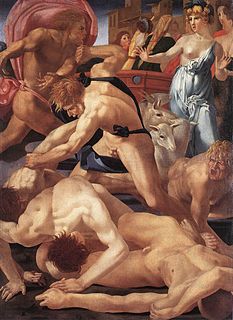 W
WThe Brazen Serpent is a 1630–1640 painting by the Aragonese artist Jusepe Leonardo, now in the Real Academia de Bellas Artes de San Fernando in Madrid. It shows the story from Book of Numbers 21: 6–9.
 W
WThe Brazen Serpent is a painting by Peter Paul Rubens, probably dating to between 1635 and 1640. It is now in the National Gallery in London. Its shows a scene from the Old Testament.
 W
WThe Brazen Serpent is a 1618-1620 oil on canvas painting by Anthony van Dyck, now in the Museo del Prado in Madrid. Its shows a scene from the Old Testament.
 W
WChrist with Moses and Solomon is a 1541-1542 oil on canvas painting by Moretto da Brescia, displayed on the altar of the Most Holy Sacrament in the collegiate church of Santi Nazaro e Celso in Brescia, the artist's home town. It has been the altarpiece for that altar throughout the historical record, from Bernardino Faino's mention of it in 1630 to the present day
 W
WThe Crossing of the Red Sea is a fresco executed in 1481–1482 and located in the Sistine Chapel, Vatican City. Of uncertain attribution, it has been assigned to one between Domenico Ghirlandaio, Biagio d'Antonio or Cosimo Rosselli.
 W
WThe Crossing of the Red Sea, also known as The Crossing of the Red Sea and Moses Appointing Joshua, is a fresco painting by the Italian artist Agnolo di Cosimo, known as Bronzino, finished in 1542. It is housed in the Palazzo Vecchio, Florence. In 1540, Cosimo I de' Medici and/or his wife, Eleanor of Toledo, commissioned this and other frescoes for Eleanor's private chapel. Three of the four walls of the small chapel found on the second floor of the palace are covered with works telling the story of Moses.
 W
WThe Crossing of the Red Sea is a painting by Nicolas Poussin, produced between 1633 and 1634. It depicts the crossing of the Red Sea by the Israelites, from chapter 14 of the book of Exodus. It was made as part of a pair of paintings commissioned by Amadeo dal Pozzo, Marchese di Voghera of Turin, a cousin to Cassiano dal Pozzo, Poussin's main sponsor in Rome. By 1685 the pair had passed to the Chevalier de Lorraine and in 1710 they were bought by Benigne de Ragois de Bretonvillers.
 W
WThe Descent from Mount Sinai is a fresco by the Italian Renaissance painter Cosimo Rosselli and his assistants, executed in 1481–1482 and located in the Sistine Chapel, Rome. It depicts the prophet Moses in the process of receiving and introducing the Ten Commandments.
 W
WThe Disputation of the Sacrament, or Disputa, is a painting by the Italian Renaissance artist Raphael. It was painted between 1509 and 1510 as the first part of Raphael's commission to decorate with frescoes the rooms that are now known as the Stanze di Raffaello, in the Apostolic Palace in the Vatican. At the time, this room was known as the Stanza della Segnatura, and was the private papal library where the supreme papal tribunal met.
 W
WThe Fifth Plague of Egypt is an oil painting by Romantic English artist Joseph Mallord William Turner currently in the permanent collection at the Indianapolis Museum of Art. Despite its title, it depicts Moses cursing the Egyptians with a plague of hail and fire, known as the seventh plague.
 W
WThe Finding of Moses, sometimes called Moses in the Bullrushes, Moses Saved from the Waters, or other variants, is the story in chapter 2 of the Book of Exodus in the Hebrew Bible of the finding in the River Nile of Moses as a baby by the daughter of Pharaoh. The story became a common subject in art, especially from the Renaissance onwards.
 W
WMoses and the Messengers from Canaan is a painting by the Italian Baroque painter Giovanni Lanfranco. It is housed in the J. Paul Getty Museum located in Los Angeles, California.
 W
WMoses Breaking the Tablets of the Law is a 1659 painting of the prophet Moses by the Dutch artist Rembrandt. It depicts Moses about to break the original two stone tablets inscribed with the Ten Commandments. It is now in the Gemäldegalerie, Berlin.
 W
WMoses Defends Jethro's Daughters is a c.1523-1524 oil on canvas painting attributed to Rosso Fiorentino, now in the Uffizi in Florence, which acquired it in 1632. It depicts Moses defending the seven daughters of Jethro, his father-in-law.
 W
WMoses Elects Seventy Elders is a painting by Jacob de Wit, completed in December 1737 and commissioned for the interior of the City Hall in Amsterdam. It shows Moses electing seventy elders and is now in the Royal Palace of Amsterdam. It is one of thirteen paintings by the artist on Hebrew Bible themes.
 W
WMoses Leaving for Egypt is a fresco by the Italian Renaissance painter Pietro Perugino and his workshop, executed around 1482 and located in the Sistine Chapel, Rome. It depicts a journey by the prophet Moses.
 W
WThe Presentation at the Temple is a painting by the Italian late medieval painter Ambrogio Lorenzetti, signed and dated 1342, now housed in the Uffizi Gallery of Florence, Italy. It is one of the largest works by the Italian medieval painter, as well as one of the five which he signed and dated.
 W
WThe painting of the Purification of the Virgin is a High-Renaissance-style tempera panel piece from an altarpiece painted by Benozzo Gozzoli and once owned by the Compagnia di Santa Maria della Purificazione e di San Zanobi of Florence, Italy. The painting is on display in the Philadelphia Museum of Art in Philadelphia, Pennsylvania, United States of America.
 W
WPresentation of Christ in the Temple is a small 1445 painting by the German artist Stefan Lochner, now in the Gulbenkian Foundation, Lisbon. It was once the wing of a diptych, the opposite, now separated, panel was a depiction of the Nativity. Its reverse shows the Stigmatisation of St. Francis. The panel is dedicated to St. Catherine and shows the purification of the Virgin. It is the first of two of Lochner's treatments of the subject - a larger painting completed two years later is kept at the Hessisches Landesmuseum, Darmstadt, Germany. The two panels are the only known dated paintings left by Lochner.
 W
WThe Punishment of the Sons of Korah or Punishment of the Rebels is a fresco by the Italian Renaissance painter Sandro Botticelli, executed in 1480–1482 in the Sistine Chapel, Rome.
 W
WThe Salvation Triptych is a triptych in oils on canvas by Moretto da Brescia, dating to 1521–1524 or 1527–28. All three of its panels are now in private collections, two in Brescia and one in Biella.
 W
WThe Stories of Moses and the Evangelists are a series of oil on panel paintings by Domenico Beccafumi, dating to circa 1538-1539 and hanging in Pisa Cathedral. They form part of a decorative scheme of 27 panels, only completed at the end of the 17th century, also including works by Andrea del Sarto and Il Sodoma.
 W
WThe Test of Fire of Moses is a painting by the Italian Renaissance master Giorgione created c. 1502-1505. It is housed in the Galleria degli Uffizi of Florence.
 W
WThe Testament and Death of Moses is a fresco attributed to the Italian Renaissance painters Luca Signorelli and Bartolomeo della Gatta, executed in around 1482 and located in the Sistine Chapel, Rome.
 W
WVictory O Lord! is an 1871 painting by John Everett Millais depicting Moses, Aaron and Hur during the Battle of Rephidim against the Amalekites. Along with his landscape Chill October it represented a major turning point in Millais career.
 W
WA Vision of the Last Judgement is a painting by William Blake that was designed in 1808 before becoming a lost artwork. The painting was to be shown in an 1810 exhibition with a detailed analysis added to a second edition of his Descriptive Catalogue. This plan was dropped after the exhibition was cancelled, and the painting disappeared. Blake's notes for the Descriptive Catalogue describe various aspects of the work in a detailed manner, which allow the aspects of the painting to be known. Additionally, earlier designs that reveal similar Blake depiction of the Last Judgement have survived, and these date back to an 1805 precursor design created for Robert Blair's The Grave. In addition to Blake's notes on the painting, a letter written to Ozias Humphrey provides a description of the various images within an earlier design of the Last Judgement.
 W
WThe Youth of Moses or The Trials of Moses is a fresco by the Italian Renaissance painter Sandro Botticelli and his workshop, executed in 1481–1482 in the Sistine Chapel, Rome.